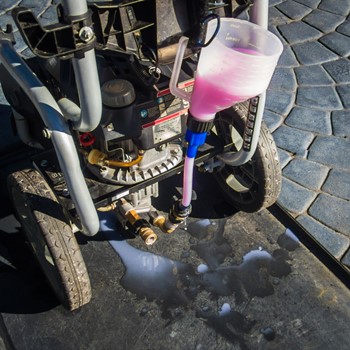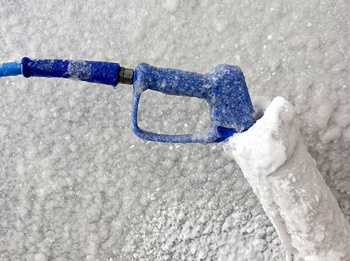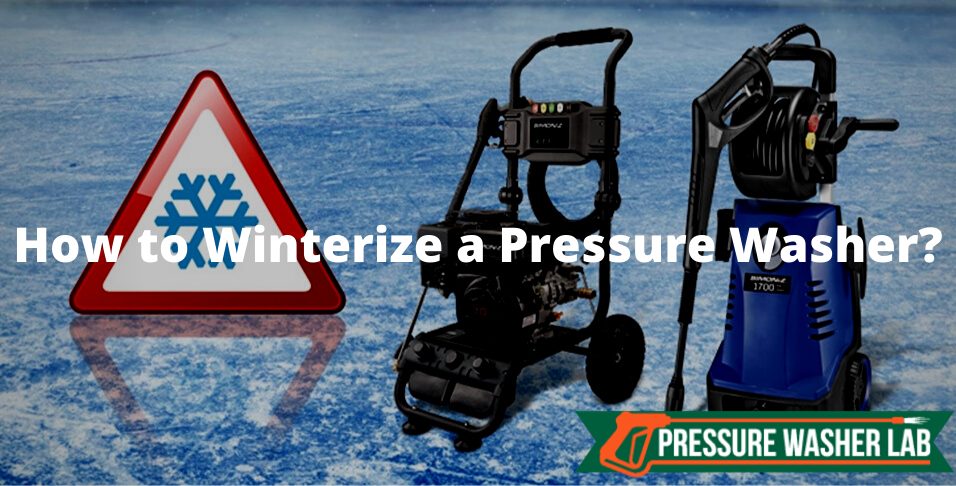To winterize a pressure washer, flush out any remaining water and detergent from the system using a bucket of clean water, disconnect all the attachments, dry the unit, and connect a pump saver to it to lubricate seals and pistons and prevent rust and freeze damage. Store the pressure washer in a cool and dry place.
Winterizing a Gas Pressure Washer
 To winterize a gas pressure washer, both the engine and the pump of the unit should be winterized.
To winterize a gas pressure washer, both the engine and the pump of the unit should be winterized.
Steps for winterizing a gas pressure washer are listed below:
- Turn off the water and water supply.
- Detach the drain hose from the pressure washer.
- Use the detergent tube to suck on some water from a bucket filled with fresh water and use it to run clean water through the pressure washer.
- Dry the unit completely, otherwise, any remaining water can damage its metal casing,
- Disconnect all the hoses from the pressure washer.
- Pour a bit of oil into the spark plug hole to prevent the inner parts of the pressure washer from getting rusty.
- Rock the unit’s engine back and forth a couple of times.
- Connect the pump saver to the garden hose inlet and fill the chamber to prevent moisture and mineral deposits from building up within.
- Place the pressure washer in a safe and dry place during the winter.
Pro Tips:
The best way to ensure a gas pressure washer’s life is to use ethanol-free fuel or at least regular fuel that has the least ethanol. Some gas companies use a mix of regular gas and ethanol that can cause varnish buildup within the fuel tank or make it corrode or rust, which is why using this type of product should be avoided.
When winterizing a pressure washer, one may want to drain all the gasoline out of the system. Use a pair of fuel line clamps, a pair of pliers, a screwdriver, and a container to drain the fuel into. Clamp off the fuel line, pull it away, and direct it towards the container. Once there is no more fuel left, reattach the fuel line. Then, take a screwdriver to open the carburetor bowl valve and dump the gas out of it. When all the fuel is drained out of the carburetor, put the screw back.
To make sure the fuel is flowing smoothly through your pressure washer’s system, add a fuel stabilizer to the pressure washer before starting it the first time in the spring.
Winterizing The Engine of a Gas Pressure Washer
Steps for winterizing the engine of a gas pressure washer are listed below:
- Mix fresh gasoline and high-quality fuel stabilizer,
- Pour the mixture into the pressure washer’s engine,
- Run the unit for 2-3 minutes so the fuel system stabilizes the fuel and to make sure the fuel lines don’t get clogged with gas during storage,
- Connect a pump saver,
- Store the pressure washer in a dry and clean place.
Winterizing The Pump of a Gas Pressure Washer
Steps for winterizing the pump of a gas pressure washer are listed below:
- Disconnect all gun and wand assembly and all the hoses from the pressure washer.
- Drain as much water from the system as possible.
- Attach a pump saver to the water inlet.
- Open the bottle and pull the pressure washer’s cord 4 to 5 times by pressing the switch on and off.
- Wait until 100% of the liquid is out of the system.
Winterizing an Electric Pressure Washer
Steps for winterizing an electric pressure washer are listed below:
- Fill the 1-gallon container of your pressure washer with hot water.
- Fill up the detergent tanks or attach the detergent siphon hose to the container with hot water.
- Turn the pressure washer on.
- Run the unit on low pressure for 30 to 60 seconds to get detergent, sediments, and debris from the system.
- Detach the garden hose from the pressure washer.
- Disconnect the trigger gun and wand.
- Turn the unit on and let it work for about 10 seconds.
- Rock it back and forth to make all the residual water come out of the system.
- Unplug the unit, attach a pump saver to the water inlet, and start squeezing the bottle so the liquid can enter the pump system.
- Turn the pressure washer on and squeeze the bottle a couple of times more until it is half empty.
- Leave the liquid within the pressure washer’s pump until spring, then flush it out before the next use.
- Store the pressure washer in a dry and safe place (f.r. garage or basement).
Pro tip: Use a pump saver with an automatic shutoff valve and the pressure washer will start sucking the liquid inside without requiring you to squeeze the bottle.
FAQ About Winterizing a Pressure Washer
1. Do I Need to Winterize My Pressure Washer?
You do need to winterize your pressure washer in order to maintain and lubricate the inner seals, prevent the pump from freezing (which causes permanent damage), cracking, or dry rot – all in all, to extend the pressure washer’s lifespan. Winterizing a gas pressure washer is crucial because gas pressure washers work on the actual fuel that is more likely to freeze and cause damage to the pressure washer. Winterizing a pressure washer is essential for whenever the unit is going to be stored for longer than 30 days.
2. What Happens If A Pressure Washer Freezes?
When a pressure washer freezes, the water that is already in the machine at the moment of freezing starts expanding, which causes damage to the pipes, pump, and valves. The rubber hosepipe is more resistant to damage, although rubber can become stiff and rupture when not being able to expand. If a pressure washer freezes, it will start producing unusual clanking and humming sounds or it will shut itself down after being turned on in the spring The manufacturer’s warranty won’t cover any damage caused by not winterizing a pressure washer.
3. How to Drain a Pressure Washer?
Fill a pressure washer’s container with hot tap water, attach a garden hose to the water inlet. Start squeezing the trigger gently and run the unit for the next 30 seconds to 2 minutes maximum to get rid of residual detergent. Disconnect the garden hose but continue squeezing the trigger to get the remaining water out. Remove all the attachments (high-pressure hose, the trigger gun, and the wand) and let the unit drain and dry out.
4. How to Use a Pump Saver?
Attach the pump saver to the water inlet, disconnect the pressure hose from the outlet, squeeze the trigger on the can a few times until about 1/3 of the bottle/can is used and the content starts coming out from the other port. Follow the first 2 steps for electric pressure washers, then pull the starter cord to make the pump system start using the content from the bottle/can. When the pump is fully lubricated, the foamy liquid will start coming out from the other port.
5. Can I Use Antifreeze Instead of a Pump Saver?
You can use biodegradable and non-toxic RV antifreeze instead of a pump saver or regular antifreeze to winterize some pressure washers but not all models. Some manufacturers recommend using a pressure washer pump saver, fuel stabilizer, or antifreeze to winterize a pressure washer. To do so, pour some liquid inside the pressure washer and leave the solution inside the pump to get the highest level of protection and lubrication and to prevent the pump from freezing. However, a pump saver already contains antifreeze that can lubricate the o-rings and pump piston, which is why using antifreeze solely would be absurd.
6. Can Pressure Washers Get Wet?
Pressure washers with IP ratings can get wet, although exposing a pressure washer to excess water for an extended period of time would cause permanent damage to the unit either way, especially if it is an electric pressure washer (gas pressure washers are more resistant to water). The higher the rating of the pressure washer, the safer the unit is to be used in wet conditions, yet still no pressure washer should be exposed to heavy rain, no matter the rating. Some pressure washers don’t have an IP rating and should not be used in damp conditions.
7. Can I Use My Pressure Washer in Winter?
 Yes, a pressure washer can be used in the winter months as long as it is used at the warmest part of the day and the engine is properly lubricated. The best time of the day to use a pressure washer in winter is between the late morning and mid-afternoon. Do not use it when the temperature drops below 0 degrees Celsius or 32 degrees Fahrenheit because the water itself will freeze or when the chilly wind is blowing. If a pressure washer is, for any reason, used on a cold day (yet, still not at temperatures below 1.7 degrees Celsius), it should be pointed downwards. The temperature of the water within the machine should be set at 180 to 200 degrees, which will prevent the water from freezing.
Yes, a pressure washer can be used in the winter months as long as it is used at the warmest part of the day and the engine is properly lubricated. The best time of the day to use a pressure washer in winter is between the late morning and mid-afternoon. Do not use it when the temperature drops below 0 degrees Celsius or 32 degrees Fahrenheit because the water itself will freeze or when the chilly wind is blowing. If a pressure washer is, for any reason, used on a cold day (yet, still not at temperatures below 1.7 degrees Celsius), it should be pointed downwards. The temperature of the water within the machine should be set at 180 to 200 degrees, which will prevent the water from freezing.
8. Should I Cover My Pressure Washer?
You should cover your pressure washer with a cover to protect it from moisture, dust, rust, and bugs. A cover also protects it from flying debris, sun rays, and precipitation if the unit is stored outside. Use a cover made of polyester or canvas with waterproof, water-repelling, or water-resistant coating casing (such as polyethylene) that protects the unit from the elements but it is still breathable. Measure the unit well and make sure the cover provides a snug fit so no part is left exposed.
Summary
To make sure your unit runs like clockwork and prevent internal rusting, buildups, and other damages, you should learn how to winterize a pressure washer. Drain all the water out of it, lubricate the inside of the pressure washer using a pump saver, and store it in a dry, possibly warm place, until the next use – that’s the whole science behind pressure washer winter maintenance.

